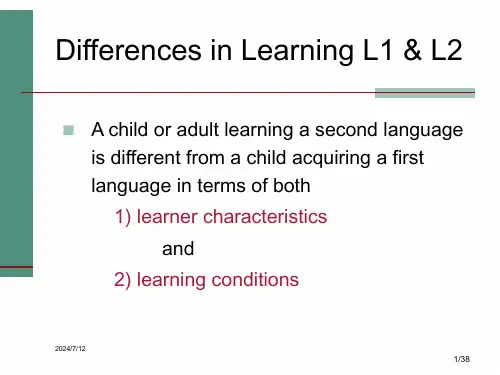克拉申第二语言习得理论-PPT课件
- 格式:ppt
- 大小:242.50 KB
- 文档页数:30



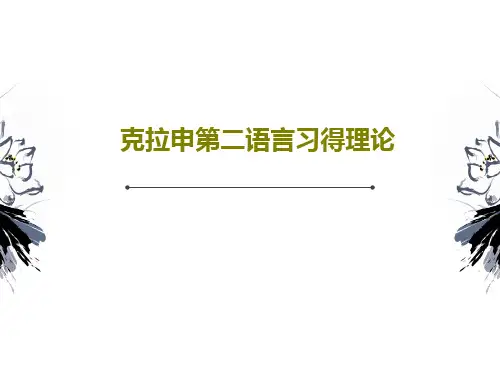

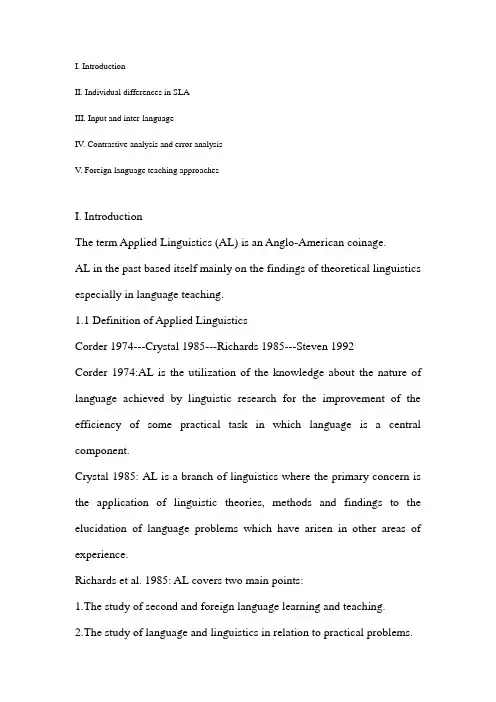
I. IntroductionII. Individual differences in SLAIII. Input and inter-languageIV. Contrastive analysis and error analysisV. Foreign language teaching approachesI. IntroductionThe term Applied Linguistics (AL) is an Anglo-American coinage.AL in the past based itself mainly on the findings of theoretical linguistics especially in language teaching.1.1 Definition of Applied LinguisticsCorder 1974---Crystal 1985---Richards 1985---Steven 1992Corder 1974:AL is the utilization of the knowledge about the nature of language achieved by linguistic research for the improvement of the efficiency of some practical task in which language is a central component.Crystal 1985: AL is a branch of linguistics where the primary concern is the application of linguistic theories, methods and findings to the elucidation of language problems which have arisen in other areas of experience.Richards et al. 1985: AL covers two main points:1.The study of second and foreign language learning and teaching.2.The study of language and linguistics in relation to practical problems.Steven 1992:AL is a multidisciplinary approach to the solution of language-related problems.The problems it attempts to solve include speech pathology, machine translation, national language planning policy, various facets of communication research and many others.HU Zhuang Lin 2004:Applied Linguistics (AL) serves as a mediating area which interprets the results of linguistic theories and makes them user friendly to the language teacher and learner.1.2 EFL and ESL(EFL) ENGLISH AS A FOREIGN LANGUAGE : Learning English in a community that doesn’t speak English.(ESL) ENGLISH AS A SECOND LANGUAGE: Leaning English in a place where it is the spoken language.According to UNESCO, second language is a language acquired/learned by a person in addition to his mother tongue.1.3 Learning and AcquisitionLearning is a deliberate, conscious attempt to master a language, while acquisition is a less deliberate, subconscious process of mastering language.As a L2 learner, you can hardly speak in the same way as a native speaker. Phonologically, morphologically, syntactically, semanticallyand pragmatically, there bound to be some differences.1.4 First and Second Language AcquisitionThink about a baby acquiring his first language.Think about a person acquiring a second language.What similarities and differences are there in the two processes? Second language learning :painstaking unsuccessfulFirst language acquisition: unconscious successfulFeature 1: Commandchildren normally achieve perfect L1 masteryadult L2 learners are unlikely to achieve perfect L2 mastery Feature 2: Successsuccess guaranteed complete success rareFeature 3: Intuitionschildren develop clear intuitions about correctnessL2 learners are often unable to form clear grammaticality judgments (The house is easy to catch fire.)Feature 4: Negative evidencecorrection not found and not necessarycorrection generally helpful or necessaryFeature 5: GoalsTarget language competenceL2 learners are more concerned with fluency than accuracy, as targetlanguage competence is too difficult to achieve.II. Individual differences in SLAIndividual differences: Age, Personality traits, Cognitive style, Learning strategies, Motivation, Language aptitude2.1 Age and Second Language AcquisitionIs it better to learn a second language when one is young or when one is older? Why?Lenneberg (1967) stated that L2 is best learned between age 2 and puberty.Case studyDo we actually find such a critical period for L2 acquisition?What would a critical period for L2 acquisition look like?Do late learners ever attain nativelikeness?Critical period for L2 acquisitionGeometric features”Heightened sensitivity at beginningClear point where offset (decline) beginsFlat period when critical period is overTemporal features”Heightened sensitivity through early childhoodSensitivity bottoms out when full neurocognitive maturity is reached Continued low sensitivity throughout adulthoodTentative conclusionsIs there a sharp cutoff point where sensitivity begins to decline? NO Does sensitivity flatten out in adulthood? NOIs there a significant change in sensitivity when maturation is reached? NOAdvantages to being a younger learnerMore likely to develop a native-like accentLess to learn to be considered proficientMore likely to receive comprehensible inputAdvantages to being an older learnerCan consciously use strategies to aid learningHas knowledge from L1 to draw fromHas greater control over inputGrammatical CompetenceMastery of language code: Lexicon (vocabulary), Word formation rules, Sentence formation rules, Pronunciation rules, Spelling rules Sociolinguistic CompetenceMastery of appropriate language use in different contextsHow to speak to a friendHow to speak to someone in authorityHow to speak socially vs. ProfessionallyDiscourse CompetenceMastery of how to combine meanings and forms to create a text in different modesExamples: Telephone inquiry ,Narrative text, Oral reportStrategic CompetenceMastery of verbal and non-verbal strategies to compensate for breakdowns in communicationExamples: How to ask for help How to rephrase a statement2.2 MotivationThere isn’t much theory that “provides an all-round explanation of what we do and why.”(Dörnyei 2003:1)“Motivation is a multifaceted construct, and the exact nature of the constituent components activated in a particular situation depends greatly on contextual factors.”(Dörnyei 2003:1) Instrumental motivation--- Immediate achievement Go abroad Social responsibility Individual development----Instrumental motivationCultural motivation---Intrinsic interest Go abroad Social responsibility Information medium---Integrative motivation Interest motivationSituational motivation---Learning situation---Situational motivation Metacognitive strategiesA. Centering your learningB. Arranging and planning your learningC. Evaluating your learningAffective strategiesA. Lowering your anxietyB. Encouraging yourselfC. Taking your emotional temperatureSocial strategiesA. Asking questionsB. Cooperating with othersC. Empathizing with othersResearch has demonstrated(1) Learners are actively involved in their learning.(2) Learners use different kinds of strategies(3) Learners have different beliefs about strategy use and learning approaches(3) Several factors have powerful influence on strategy choice/use: motivation, proficiency, years of study,sex, major, if requirementThe good language learner:(1) is guesser, but an accurate guesser!(2) has a strong drive to communicate.(3) is not often inhibited (a risk-taker).(4) focuses on communication, but also attends to form.(5) practices—and creates opportunities to do so.(6) knows what is appropriate.(7) monitors his own and the speech of others.(8) attends to meaning.(9) Actively participates (aloud and silently).III. Input and Inter-language3.1 Input theory by Krashen Interaction theory by Long Output theory by Swain3.2 InterlanguageDefinition of inputQuestion:Could you explain “input”in second language acquisition?Learners' most direct source of information about the target language is the target language itself. When they come into direct contact with the target language, this is referred to as "input." (/wiki)Stephen Krashen (University of Southern California) is an expert in the field of linguistics, specializing in theories of language acquisition and development. Much of his recent research has involved the study of non-English and bilingual language acquisition. During the past 20 years, he has published well over 100 books andarticles and has been invited to deliver over 300 lectures at universities throughout the United States and Canada.3.1 Krashen’s Input HypothesisKrashen's theory of second language acquisition consists of five main hypotheses:1) the Acquisition-Learning hypothesis,2) the Monitor hypothesis,3) the Natural Order hypothesis,4) the Input hypothesis,5) the Affective Filter hypothesis.Input Hypothesis"The best methods are therefore those that supply 'comprehensible input' in low anxiety situations, containing messages that students really want to hear. These methods do not force early production in the second language, but allow students to produce when they are 'ready', recognizing that improvement comes from supplying communicative and comprehensible input, and not from forcing and correcting production."The Input hypothesis is Krashen's attempt to explain how the learner acquires a second language.This hypothesis claims that “humans acquire language in only one way-by understanding messages or by receiving ‘comprehensibleinput’”(Krashen, 1985:2)Comprehensible input: i+1; output plays little role.Comment on Input theoryInfluential: application in SLT, Types of input, Ways of input, Variety of input, Sufficiency of input, Efficiency of input Controversial:How to quantify and qualify the “i”and “1”in “i+1”Ignorance of outputViews diverge greatly as to what kind of input should be provided for language learners.Authentic input, Comprehensible input (Krashen): i+1 Premodified input, Interactively modified inputInput-based teachingDirect method, Natural approach, Total physical response, Communicative approach, Community language learning (CLL) , Suggestopedia, Silent wayLong’s Interaction HypothesisLong's interaction hypothesis proposes that language acquisition is strongly facilitated by the use of the target language in interaction. In particular, the negotiation of meaning has been shown to contribute greatly to the acquisition of vocabulary (Long, 1990).Study: NSs-NNSs, negotiation for meaning---comprehensible inputThe Interaction Hypothesis highlights the role of social interaction in increasing the amount of comprehensible input that students receive. This interaction includes students asking for help when they do not understand input. Perhaps, the collaborative setting in groups and the trust that can grow among groupmates make it more likely that students will have opportunities to repair comprehension breakdowns.Swain’s Output HypothesisMerrill Swain(Ph.D., University of California)She is Professor in the Curriculum, Teaching and Learning department at the Ontario Institute for Studies in Education (OISE) at the University of Toronto. website: http://www.oise.utoronto.ca/mlc/swain.htmThe output hypothesis claims that the act of producing language (speaking or writing) constitutes, under certain circumstances, part of the process of second language learning.It states that while comprehensible input is necessary for L2 learning, learners also need to speak and to write, i. e., produce output, in their L2.Three functions of output in second language learning:1) the noticing/triggering function 发现所想与所能之间的差别2) the hypothesis-testing function 测试语言假设3) the metalinguistic (reflective) function.增加元语言知识没有输出需要的输入不易转化为程序性知识没有输入帮助的输出不利于语言体系的拓展输出-输入结合的教学活动更具有交际的真实性(文秋芳,2008)3.2 InterlanguageThe type of language constructed by second or foreign language learners who are still in the process of learning a language is often referred to as interlanguage.It is often understood as a language system between the target language and the learner’s native language.E.g. data from SWECCLInterlanguage is a dynamic language system, which is constantly moving from the departure level to the native-like level.Can be done in two ways:investigating the psychological, biological or neurological mechanisms involved in the production of interlanguage; investigating the linguistic features of interlanguage.Concerning the linguistic features of interlanguage, the following questions can be asked:Linguistically, how is interlanguage in general different from the target language or the native language?In what way is lower level interlanguage different from higher levelinterlanguage?How is the interlanguage system used to convey meaning?IV. Contrastive Analysis and Error AnalysisWe assume that the student who comes into contact with a foreign language will find some features of it quite easy and others extremely difficult. Those elements that are similar to his native language will be simple for him, and those elements that are different will be difficult. Lado, 1957, 24.1 Contrastive Analysis (1940s ---1960s)Paul Nation is Professor in Applied Linguistics at the School of Linguistics and Applied Language Studies (LALS) at Victoria University of Wellington, New Zealand.“Research shows that the first language has a small but important role to play in communicating meaning and content.”(Paul Nation, in his article, The Role of the First Language in Foreign Language)4.1.1 Definition of Contrastive Analysis (CA)A way of comparing L1 and L2 to determine potential errors for the ultimate purpose of isolating what needs to be learned and what not in a second language learning situation. (Gass & Selinker, 2001:72) An approach to the study of SLA which involves predicting and explaining learner problems based on a comparison of L1 and L2 todetermine similarities and differences”(Saville-Troike, 2006: 34) 4.1.2 Objectives of CAProviding insights into similarities and differences between languages;Explaining and predicting problems in L2 leaningDeveloping course materials for language teaching4.1.3 Contrastive Analysis HypothesisMain assumptions1) L2 learning involves overcoming difficulties in the linguistic systems of the target language;2) The main difficulties in learning a L2 are caused by interference from the L1;3) Contrastive analysis can predict, or at least account for, difficulties in L2 learning, so teaching materials based on contrastive analysis can reduce the effects of interference and difficulties, and facilitate L2 learning.Contrastive Analysis Hypothesis"Where two languages were similar, positive transfer would occur; where they were different, negative transfer, or interference, would result." (Larsen-Freeman & Long 1991: 53)3 versions of the CA hypothesisThe Strong Version: Fries & LadoIt (a priori) claimed that prediction of difficulties in learning L2 could be made based upon a comparison of two languages. This starts with a crosslinguistic analysis and then attempts to predict trouble spots.The Weak Version: Wardhaugh (1970)It (a posteriori) claimed that cross-linguistic comparison could help to explain learner errors. This starts with learner errors and attempts to account for them with cross-grammatical comparisons.The Moderate Version: Oller & ZiahosseinyIt differs from the above two in that it emphasizes the significance of minimal distinctions, which may actually cause the greatest interferences and difficulties.4.1.4 Procedures of CA2 principles of CA as proposed by Halliday:Describe before comparingComparing patterns, not whole languagesSteps:The separate description of the relevant features of each language; The establishment of comparability;The comparison and contrast.4.1.5 Evaluation of CAHA. Application, Prediction & Diagnosis of errorsTesting, Course design, Selection, Grading,Contrastive teaching B. Problems with contrastive analysisProblem #1The predictions made by proponents of the CAH were often inaccurate, or even false.There was underprediction (i.e. the CAH failed to predict some errors).There was overprediction (i.e. the CAH predicted errors that did not materialize).French object pronouns precede the verb: Je les vois "I them see." English L1 learners of French will say:*"Le chien a mange les" instead of "Le chien les a mange*"Il veute les encore" instead of "Il les veut encore"" (Ervin-Tripp, 1974)But, French L1 learners of English do not say"I them see." (Je les vois) instead of "I see them"Why does it work one way but not the other?Problem #2It is not true that similarity always equals ease of learning and difference always equals difficulty; (sometimes it’s the other way round)Problem #3L1 transfer is effected by other factors, e.g. the amount and type of TL exposure learners receive.Problem #4Many studies have shown SLLs from very different L1 backgrounds make similar errors.This suggests that many of the most common learner errors are not due to interference of native language.See Ortega, 2009. Section 3.1 p. 310nly about 30% of errors have been attributed to L1. This ranges from 3% for child Spanish learners of English (Dulay & Burt, 1973) to 50% for adult Chinese ESL (Tran Chi Chau 1975)ConclusionWhile interference plays a role in SLA, so do many other factors and thus the role of the first language is less than what was thought by proponents of CA.4.2 Error AnalysisEA refers to the study and analysis of the errors made by second and foreign language learners.Purposes of EA:1) identify strategies which learners use in language learning;2) identify the causes of learner errors;3) obtain information on common difficulties in language learning,as an aid to teaching or in the preparation of teaching materials.4.2.1 Error and mistakeError: Systematic deviation by learners who have not yet mastered the rules. More difficult to correct. Indication of learner’s attempt to figure out the L2 systemMistake: Random performance slip caused by fatigue, excitement, etc. Readily self-corrected.4.2.2 Types of errorsStructural errors (breaking of a rule)e.g. (1) The fast economic growth causes people’s living condition has improved.(2) The job is fit me very well.(3) 报有希望carry the hope; entertain the hope(4) 找借口look for an excuse; make an excuse(5) rather proud, good, young, fresh, practicalquite annoyed, nervous, wrong, serious, limited, difficult, common Non-structural errors,deviations from some kind of norm ('breaches of code') quantitative differences (overuse, underuse)E.g. No smoking, please.Overuse of “make”, “happy”, “glad”.Underuse synonyms of “happy”such as cheerful, light-hearted,delighted etc.Interlingual errors (transfer errors): misuse of an item because of L1 influence. based on cross-linguistic comparisonsIntralingual errors (developmental errors): within L2 (e.g. overgeneralization) based on language being learned4.2.3 Procedure of error analysis1. Collection of samples of learner language2. Identification of errors3. Description of errors4. Explanation of errors (Ellis 1994)4.2.4 Problems with Error Analysis1) Focus on errors mean that researchers ignored what the learner did right.2) Empirically it was difficult to identify the source of many errors.3) It doesn't account for all the problems that learners have, e.g. Avoidance. Learner avoids a certain word or structure.V. Foreign Language Teaching MethodologyDiscussion:What teaching method do you know in ELT?On which theory is it founded?A Retrospective of Foreign Language Teaching Methodology Traditional gramma: Classical language teaching (before 1880)Grammar- Translation MethodStructuralism: Beginning of Modern Language Teaching (from 1880 to the 1st world war): Direct methodMentalism: Development of Modern Language Teaching (from the 1st World War to ’70) : Cognative MethodFunctionalism: Intensification of Modern Language Teaching (after ’70): Communicative MethodConstructivism: Improvement of Modern Language Teaching( after 1980’s) : Constructivist MethodPost-modernism : Perfection of Modern Language Teaching(after1990’s): Post-method1) Traditional grammar---Grammar-Translation Method Correctness, literary excellence, the use of Latin models, the priority of the written languageTextbook takes prominent writers as language models.Teaching involves the presentation of numerous definition, rules and explanations.2) Structuralist linguistics---Direct methodThe spoken language in people’s communication.The focus on the grammatical structures of a language.A pattern drill technique aiming at the learner’s automatisms for language forms.3)Mentalism/Transformational-GenerativeLinguistics---Audio-lingual Method把语言看成一个内在的规则系统( a system of innate rule),认为语言学习者有一种普遍的语言知识(linguistic competence)。
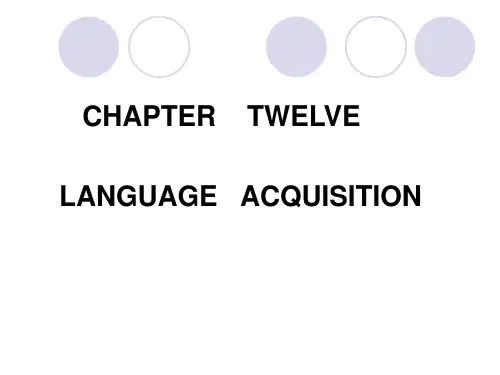

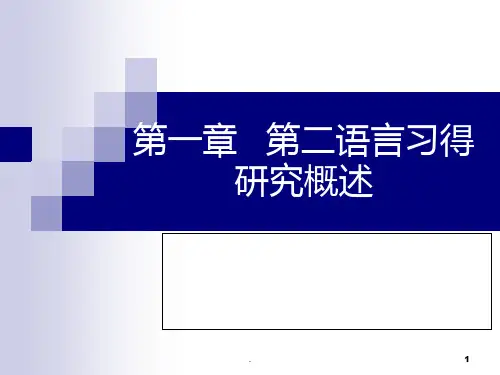
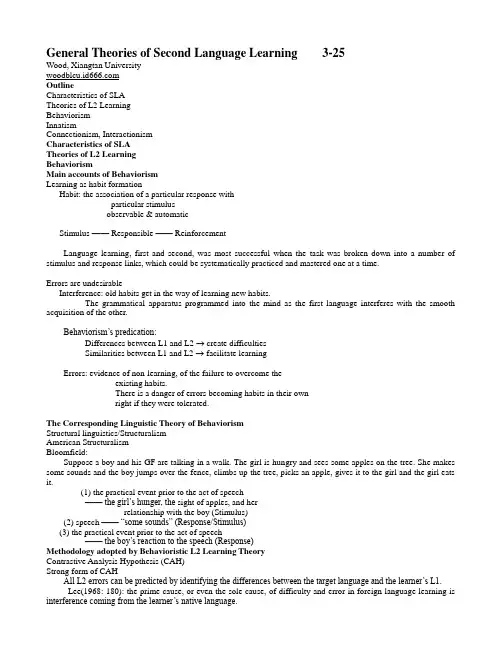
General Theories of Second Language Learning 3-25Wood, Xiangtan UniversityOutlineCharacteristics of SLATheories of L2 LearningBehaviorismInnatismConnectionism, InteractionismCharacteristics of SLATheories of L2 LearningBehaviorismMain accounts of BehaviorismLearning as habit formationHabit: the association of a particular response withparticular stimulusobservable & automaticStimulus —— Responsible —— ReinforcementLanguage learning, first and second, was most successful when the task was broken down into a number of stimulus and response links, which could be systematically practiced and mastered one at a time.Errors are undesirableInterference: old habits get in the way of learning new habits.The grammatical apparatus programmed into the mind as the first language interferes with the smooth acquisition of the other.Behaviorism‘s predication:Differences between L1 and L2 → create difficultiesSimilarities between L1 and L2 → facilitate learningErrors: evidence of non-learning, of the failure to overcome theexisting habits.There is a danger of errors becoming habits in their ownright if they were tolerated.The Corresponding Linguistic Theory of BehaviorismStructural linguistics/StructuralismAmerican StructuralismBloomfield:Suppose a boy and his GF are talking in a walk. The girl is hungry and sees some apples on the tree. She makes some sounds and the boy jumps over the fence, climbs up the tree, picks an apple, gives it to the girl and the girl eats it.(1) the practical event prior to the act of speech——the girl‘s hunger, the sight of apples, and herrelationship with the boy (Stimulus)(2) speech ——―some sounds‖ (Response/Stimulus)(3) the practical event prior to the act of speech——the boy‘s reaction to the speech (Response)Methodology adopted by Behavioristic L2 Learning TheoryContrastive Analysis Hypothesis (CAH)Strong form of CAHAll L2 errors can be predicted by identifying the differences between the target language and the learner‘s L1.Lee(1968: 180): the prime cause, or even the sole cause, of difficulty and error in foreign language learning is interference coming from the learner‘s native language.Weak form of CAHCA can be used to identify which errors are the result of interference.Implicit assumption of weak version: NOT all errors are the result of interference.Contrastive Analysis in Linguistic sense—— Comparative LinguisticsStructural linguistics emphasizes the differences among languages.Bloomfield (1933): The differences (among languages) are great enough to prevent our setting up any system of classification that would fit all languages.Description → Selection → Comparison → Prediction陆俭明(2003: 225):我们的汉语研究一直是在强调汉语特点的呼声中推进的,上个世纪80年代到90年代,对汉语特点的强调可以说达到了顶峰。
